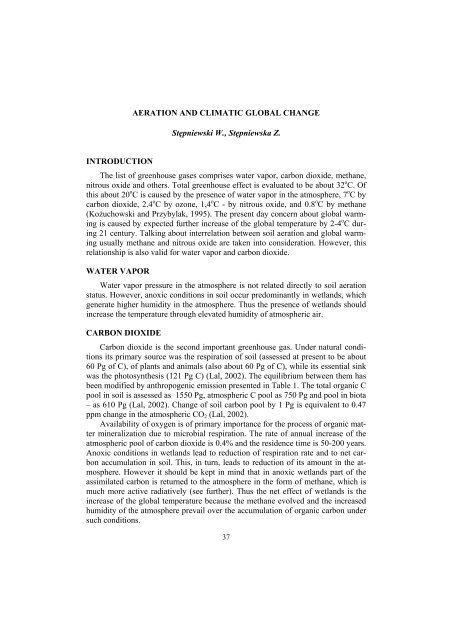soil - Lublin
soil - Lublin
soil - Lublin
Create successful ePaper yourself
Turn your PDF publications into a flip-book with our unique Google optimized e-Paper software.
AERATION AND CLIMATIC GLOBAL CHANGE<br />
Stępniewski W., Stępniewska Z.<br />
INTRODUCTION<br />
The list of greenhouse gases comprises water vapor, carbon dioxide, methane,<br />
nitrous oxide and others. Total greenhouse effect is evaluated to be about 32 o C. Of<br />
this about 20 o C is caused by the presence of water vapor in the atmosphere, 7 o C by<br />
carbon dioxide, 2.4 o C by ozone, 1,4 o C - by nitrous oxide, and 0.8 o C by methane<br />
(Kożuchowski and Przybylak, 1995). The present day concern about global warming<br />
is caused by expected further increase of the global temperature by 2-4 o C during<br />
21 century. Talking about interrelation between <strong>soil</strong> aeration and global warming<br />
usually methane and nitrous oxide are taken into consideration. However, this<br />
relationship is also valid for water vapor and carbon dioxide.<br />
WATER VAPOR<br />
Water vapor pressure in the atmosphere is not related directly to <strong>soil</strong> aeration<br />
status. However, anoxic conditions in <strong>soil</strong> occur predominantly in wetlands, which<br />
generate higher humidity in the atmosphere. Thus the presence of wetlands should<br />
increase the temperature through elevated humidity of atmospheric air.<br />
CARBON DIOXIDE<br />
Carbon dioxide is the second important greenhouse gas. Under natural conditions<br />
its primary source was the respiration of <strong>soil</strong> (assessed at present to be about<br />
60 Pg of C), of plants and animals (also about 60 Pg of C), while its essential sink<br />
was the photosynthesis (121 Pg C) (Lal, 2002). The equilibrium between them has<br />
been modified by anthropogenic emission presented in Table 1. The total organic C<br />
pool in <strong>soil</strong> is assessed as 1550 Pg, atmospheric C pool as 750 Pg and pool in biota<br />
– as 610 Pg (Lal, 2002). Change of <strong>soil</strong> carbon pool by 1 Pg is equivalent to 0.47<br />
ppm change in the atmospheric CO 2 (Lal, 2002).<br />
Availability of oxygen is of primary importance for the process of organic matter<br />
mineralization due to microbial respiration. The rate of annual increase of the<br />
atmospheric pool of carbon dioxide is 0.4% and the residence time is 50-200 years.<br />
Anoxic conditions in wetlands lead to reduction of respiration rate and to net carbon<br />
accumulation in <strong>soil</strong>. This, in turn, leads to reduction of its amount in the atmosphere.<br />
However it should be kept in mind that in anoxic wetlands part of the<br />
assimilated carbon is returned to the atmosphere in the form of methane, which is<br />
much more active radiatively (see further). Thus the net effect of wetlands is the<br />
increase of the global temperature because the methane evolved and the increased<br />
humidity of the atmosphere prevail over the accumulation of organic carbon under<br />
such conditions.<br />
37

















